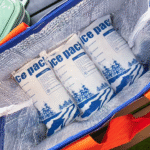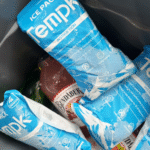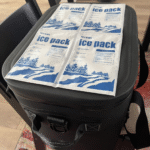Dry Ice Blocks vs. Feuilles de pack de glace sèche: Ce qui est le meilleur pour l'expédition de la chaîne du froid?
Dans la logistique de la chaîne du froid, selecting the right cooling solution is paramount. Que vous expédiiez les produits pharmaceutiques, aliments surgelés, ou échantillons biologiques, understanding the distinct properties of dry ice blocks and dry ice pack sheets can make a significant impact on your operations. Both are highly effective, but their applications vary. This article will help you navigate these options and make the right choice based on your needs.

Why is Dry Ice the Preferred Choice for Cold Chain Logistics?
Before diving into the details, it’s essential to understand why dry ice is a preferred cooling method for temperature-sensitive shipments. La glace sèche est un dioxyde de carbone solide (Co₂), which sublimates directly from a solid to a gas at -78.5°C. Contrairement à la glace ordinaire, dry ice does not leave any water residue, making it perfect for maintaining sub-zero temperatures without compromising the integrity of your goods. It is a staple for industries such as food, médicaments, and biotech due to its ability to keep items frozen while eliminating the risks associated with moisture damage.
Dry Ice Blocks vs. Feuilles de pack de glace sèche: Key Differences and Benefits
What Are Dry Ice Blocks?
Dry ice blocks are large, solid pieces of CO₂ used primarily in long-haul shipments that require extended cooling durations. These blocks offer several benefits:
-
Durée de refroidissement prolongée: Dry ice blocks provide longer-lasting cooling due to their larger mass and slower sublimation rate. This makes them ideal for multi-day shipments.
-
Versatility in Application: Disponible en différentes tailles, dry ice blocks can be used in large or customized containers, making them highly adaptable.
-
Pas de résidu: Comme la glace sèche sublime, it leaves no moisture behind, protecting sensitive items from water damage during transit.
Cependant, there are some limitations:
-
Manipulation et stockage: Dry ice blocks are heavy and require more space for storage, which could be a constraint for smaller shipments. Handling also requires protective equipment due to the extreme cold.
-
Coût: Dry ice blocks are generally more expensive than pack sheets, though they offer a more cost-effective solution for long-duration shipments.
What Are Dry Ice Pack Sheets?
Dry ice pack sheets, en revanche, are thinner and more flexible, designed to fit smaller shipments. They are often pre-packaged and can be tailored to specific cooling needs:
-
Efficace en espace: The flexibility of dry ice pack sheets allows them to fit into tight spaces, optimizing packaging and reducing wasted volume.
-
Facilité de manipulation: These sheets are lightweight and easy to handle, making them ideal for smaller shipments and reducing labor costs associated with packing and handling.
-
Pre-measured Convenience: Most dry ice pack sheets come in standardized sizes, which simplify the packing process and ensure consistency.
Cependant, they do come with trade-offs:
-
Shorter Cooling Duration: Due to their smaller mass, dry ice pack sheets sublimate more quickly than dry ice blocks. This makes them better suited for short-term cooling, such as next-day or local deliveries.
-
Risque d'humidité: If not sealed properly, these sheets can release moisture as they sublimate, potentially leading to condensation and water damage to the products.
Lequel devez-vous choisir?
1. Durée et distance d'expédition
If you need to ship goods that require extended cooling over long distances, dry ice blocks are your best bet. They maintain a consistent temperature over several days, making them ideal for international or cross-country shipments. Dry ice pack sheets are better suited for shorter, more localized shipments.
2. Size and Weight of the Shipment
Dry ice blocks work best for bulk shipments, providing the necessary cooling for large payloads. They are the preferred choice for shipments like frozen food pallets or bulk medical supplies. Dry ice pack sheets, d'autre part, excel in compact, lightweight shipments, such as small biotech samples or individual meal kits.
3. Handling and Storage Requirements
Dry ice blocks require more careful handling and proper storage due to their size and the fact that they sublimate more slowly. They also need more space in shipping containers. Dry ice pack sheets are easier to store and manage, especially for smaller operations or shipments requiring less cooling time.
4. Considérations de coûts
Dry ice blocks, while more expensive, offer better cost-efficiency for long-duration, large shipments. For smaller shipments, dry ice pack sheets provide a more budget-friendly option, especially for one-time or short-term uses.
Advantages and Disadvantages of Dry Ice Blocks vs. Feuilles de pack de glace sèche
| Fonctionnalité | Dry Ice Blocks | Feuilles de pack de glace sèche |
|---|---|---|
| Durée de refroidissement | Refroidissement durable, ideal for extended shipments | Durée de refroidissement plus courte, ideal for local or next-day shipments |
| Manutention | Requires protective equipment, heavier to handle | Léger, facile à manipuler, flexible |
| Stockage | Nécessite plus d'espace | Compact and easier to store |
| Flexibilité | Can be cut into various sizes | Pre-measured, easy to pack |
| Coût | More expensive for larger shipments | More cost-effective for smaller shipments |
Best Practices for Using Dry Ice in Cold Chain Logistics
To optimize your dry ice usage, keep the following best practices in mind:
Choisissez la bonne taille et la bonne quantité
Ensure you select the correct amount of dry ice based on the shipment size and duration. Over-packing or under-packing can affect the cooling performance.
Use Appropriate Insulation
Pair your dry ice with high-quality insulation to extend its cooling duration and maintain a consistent temperature. Materials like vacuum insulation panels or high-density foam work well in extending the life of your dry ice.
Assurer une bonne ventilation
La glace sèche sublime dans le gaz co₂, so it’s critical to leave space for the gas to escape. Proper ventilation in your packaging prevents pressure build-up, which could lead to dangerous situations.
Account for Regulations
Shipping dry ice is subject to specific regulations, including labeling and documentation requirements from agencies such as the DOT and IATA. Always ensure that your shipment complies with these regulations.
Latest Trends in Dry Ice for Cold Chain Logistics in 2025
L'industrie de la logistique de la chaîne du froid évolue continuellement. Here are some of the latest trends impacting the use of dry ice:
New Technological Innovations
-
Solutions d'emballage intelligents: IoT-enabled sensors are increasingly integrated into dry ice packaging, enabling real-time temperature tracking and better monitoring throughout transit.
-
Alternatives respectueuses de l'environnement: There is a growing demand for sustainable dry ice solutions, such as biodegradable and recyclable packaging materials.
Regulatory Changes
As the need for temperature-sensitive shipping grows, governments are implementing stricter regulations. These include new safety measures for handling, conditionnement, and transporting dry ice.
FAQ: Common Questions About Dry Ice Blocks and Dry Ice Pack Sheets
Q1: What’s the main difference between dry ice blocks and dry ice pack sheets?
Dry ice blocks are larger, provide longer cooling durations, and are ideal for bulk shipments, while dry ice pack sheets are more flexible and perfect for smaller, short-duration shipments.
Q2: Can I use dry ice blocks for small shipments?
While dry ice blocks can be used for small shipments, they are typically better suited for larger shipments requiring long-lasting cooling.
Q3: Combien de temps dure la glace sèche dans une expédition?
The cooling duration depends on the amount of dry ice used, the type of packaging, and the shipment’s size. En général, dry ice blocks last longer than pack sheets.
Conclusion: Making the Right Choice for Your Cold Chain Needs
Both dry ice blocks and dry ice pack sheets have their unique advantages. Dry ice blocks are the go-to solution for long-duration, large shipments, while dry ice pack sheets provide a flexible, efficient solution for smaller, short-duration shipments. By understanding the key differences, you can select the most appropriate option for your specific needs and optimize your cold chain logistics operations.
À propos du tempk
Et tempk, we specialize in providing reliable and innovative cold chain solutions. Whether you need dry ice blocks, pack sheets, or insulated containers, our products ensure that your temperature-sensitive shipments arrive safely and on time. Let us help you design the perfect solution tailored to your needs.























